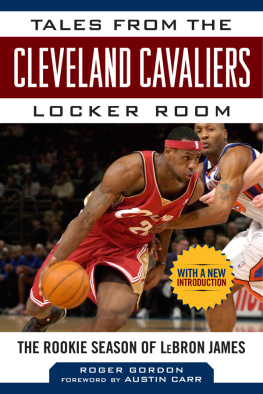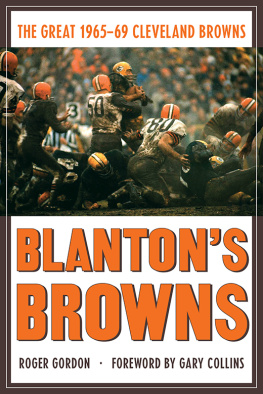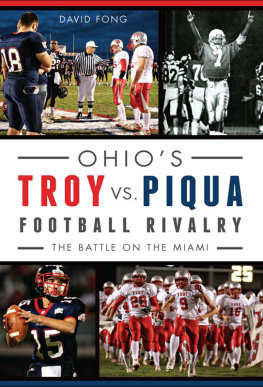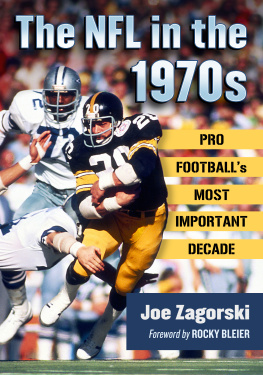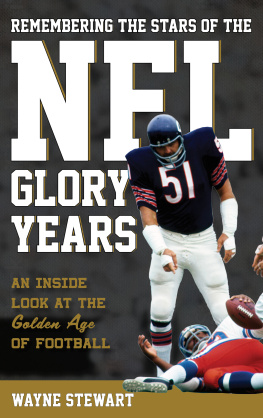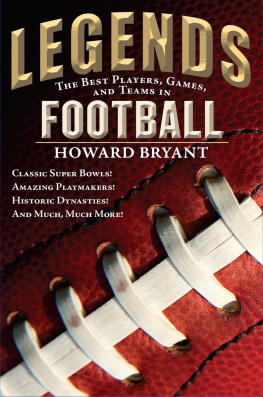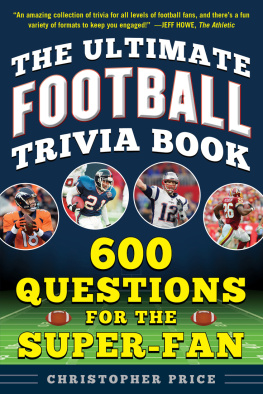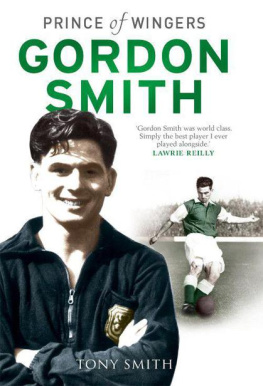ACKNOWLEDGMENTS
I would like to thank Niels Aaboe of Lyons Press for giving me the opportunity to write this book and everyone else there for their assistance.
THE 1920s BIRTH OF A NEW LEAGUE
In the early 1900s, aside from baseball, college football was king. There were a few professional leagues that were centered in Illinois, New York, Ohio, and Pennsylvania. In the late teens of the twentieth century, some leagues raided local colleges for players, but no draft existed. As a result, the leagues began to consolidate in order to gain control over their rosters and expenses. In 1920, the American Professional Football Association (APFA) was born, and the pro game became much more organized. Actually, the APFA was originally known as the American Professional Football Conference. Jim Thorpe, a former football and track star at the Carlisle Indian Industrial School in Pennsylvania and a double gold-medal winner at the 1912 Summer Olympics in Stockholm, Sweden, added credibility to the sport and was the APFAs first president. A membership fee of a hundred dollars per team was charged to give an appearance of respectability, but no team ever paid it. Scheduling was left up to the teams. And many of those teams came and went. Some of the great teams in the 1920s were the Canton Bulldogs, Frankford Yellow Jackets, and Providence Steam Roller. A few of the great players were Thorpe, Red Grange, and Ernie Nevers.
QUESTIONS
- Where was the National Football League founded? Answer on page 5.
- What team was the first champion of the American Professional Football Association? Answer on page 5.
- What player with the initials G.T. was the American Professional Football Associations first all-pro center? Answer on page 6.
- Helmets were mandatory for players in the 1920s. True or false? Answer on page 6.
- What offensive formation was popular in the 1920s? Answer on page 6.
- The Decatur Staleys became the Chicago Staleys in 1921 and the Chicago Bears in 1922. The first owner of the franchise was also its first head coach. Who was he? Answer on page 7.
- Jim Thorpe played for six teams in his career, which lasted from 1920 through 1926 and 1928. Who was the first team for which he played? Answer on page 8.
- Detroit Heralds
- Rock Island Independents
- Canton Bulldogs
- Buffalo All-Americans
- What team won back-to-back NFL Championships in 1922 and 1923? Answer on page 9.
- The _____ Bulldogs won the 1924 NFL title. Answer on page 10.
- In 1924, the Rochester Jeffersons finished in last place. What was their record? Answer on page 11.
- 0-3
- 0-5
- 0-7
- 0-9
- I played halfback for seven seasons for the Chicago Bears and one season for the New York Yankees. My nickname was The Galloping Ghost. Who am I? Answer on page 11.
- The Chicago Cardinals won the 1925 NFL Championship. True or false? Answer on page 12.
- What player who suited up for five teams from 1925 through 1938 with the initials J.B. was known for crazy, legendary exploits on and off the field? Answer on page 14.
- The Los Angeles _____ played one season, 1926, and finished with a 6-3-1 record. Answer on page 15.
- The Chicago Bears would have won the 1926 NFL Championship with a 12-1-3 record, a .923 winning percentage, except for the fact that another team finished 14-1-2, a .933 winning percentage. What team was it? Answer on page 15.
- Which New York team won the 1927 NFL Championship, the Giants or the Yankees? Answer on page 16.
- What team won the 1928 NFL Championship? Answer on page 17.
- Green Bay Packers
- Providence Steam Roller
- Chicago Bears
- Detroit Wolverines
- How many NFL titles did the Green Bay Packers of the 1920s win? Answer on page 18.
- One
- Two
- Three
- Four
- What player with the initials E.N. set an NFL record that, although has been tied, still stands today6 touchdowns in one game, on Thanksgiving 1929? Answer on page 19.
- In 1929, Dayton finished in last place with an 0-6 record. What was the nickname of the team? Answer on page 20.
- Flyers
- Aztecs
- Triangles
- Bengals
ANSWERS
- Canton, Ohio. Pro football actually began in 1892 in Pittsburgh when former Yale University star William Pudge Heffelfinger was paid five hundred dollars to play in a game for the Allegheny Athletic Association on November 12. For almost the next three decades, pro football faced its ups and downs as the game was played primarily in small towns throughout western Pennsylvania and the Midwest. The NFL was born on September 17, 1920, inside an automobile showroom in Canton. Representatives of eleven pro football teams gathered to create the American Professional Football Association (APFA). Two years later, the name was changed to the National Football League.
Ralph E. Hay, a car dealer who had bought the Canton Bulldogs in 1918, met with the owners of the ten other teamsthe Decatur Staleys, Chicago Cardinals, Akron Pros, Cleveland Indians, Dayton Triangles, Massillon Tigers, Hammond Pros, Muncie Flyers, Rock Island Independents, and Rochester Jeffersons. Hay realized that they all had to organize a league if pro football was going to survive. And so the APFA was born. By the time the APFA had its first season in 1920, there were fourteen teams.
- The Akron Pros. The Pros originated as a semipro team called the Akron Indians. After experiencing financial losses from 1912 through 1919, the team in 1920 was sold to Art Ranney, an Akron businessman and former football player at the University of Akron, and Frank Nied, a cigar-store owner. Coached by Elgie Tobin, Akron finished with an 8-0-3 record and won the title based on that. There was no postseason in the APFA yet. The Pros outscored their opponents a combined 1517. Those seven points they yielded came on November 14 in a 77 tie with the Cleveland Tigers, a team comprised mainly of ex-stars from the pro team the Massillon Tigers.
Akron opened the season on October 3 with a 430 victory over the Wheeling Stogies. Al Nesser, one of the infamous football-playing Nesser Brothers, scored three touchdowns on fumble recoveries. The next week, the Pros routed the Columbus Panhandles 370. Akrons first road game came on October 31, a 100 upset of the Canton Bulldogs, who were considered to be the top team in the APFA. On November 21, Akron, behind the rushing of Fritz Pollard and Frank McCormick, defeated the Dayton Triangles 130. The last two games of the season were scoreless ties with the Buffalo All-Americans and the Decatur Staleys, respectively.
- George Trafton. Trafton played for the Decatur/Chicago Staleys in 1920 and 1921 and the Chicago Bears from 1923 through 1932. He played college football for one year at the University of Notre Dame. He was a member of Knute Rocknes 1919 Fighting Irish team that featured George Gipp. That year, the Irish finished 9-0 and were recognized as conational champions by the National Championship Foundation. As a member of the Decatur Staleys in 1920, Trafton was selected as a first-team All-Pro. In 1921, he helped the Staleys to a 9-1-1 record and the APFA Championship. After taking a year off to become an assistant coach for Northwestern University, he returned to the Chicago team in 1923. He was an integral part of several successful Bears teams. In his final season, the Bears finished 7-1-6 in winning the NFL title. He was inducted into the Pro Football Hall of Fame in 1964.


